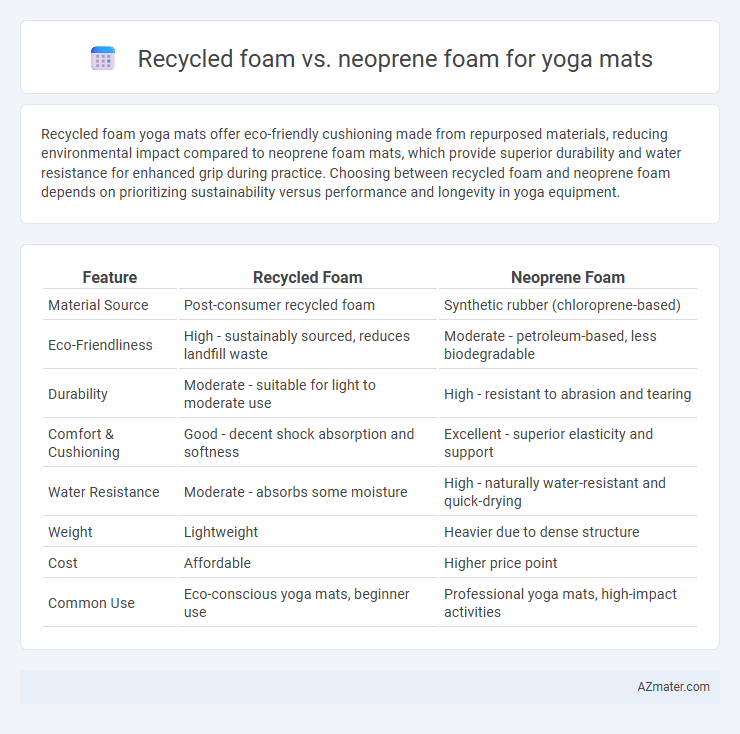Recycled foam yoga mats offer eco-friendly cushioning made from repurposed materials, reducing environmental impact compared to neoprene foam mats, which provide superior durability and water resistance for enhanced grip during practice. Choosing between recycled foam and neoprene foam depends on prioritizing sustainability versus performance and longevity in yoga equipment.
Table of Comparison
| Feature | Recycled Foam | Neoprene Foam |
|---|---|---|
| Material Source | Post-consumer recycled foam | Synthetic rubber (chloroprene-based) |
| Eco-Friendliness | High - sustainably sourced, reduces landfill waste | Moderate - petroleum-based, less biodegradable |
| Durability | Moderate - suitable for light to moderate use | High - resistant to abrasion and tearing |
| Comfort & Cushioning | Good - decent shock absorption and softness | Excellent - superior elasticity and support |
| Water Resistance | Moderate - absorbs some moisture | High - naturally water-resistant and quick-drying |
| Weight | Lightweight | Heavier due to dense structure |
| Cost | Affordable | Higher price point |
| Common Use | Eco-conscious yoga mats, beginner use | Professional yoga mats, high-impact activities |
Overview: Recycled Foam vs Neoprene Foam Yoga Mats
Recycled foam yoga mats offer an eco-friendly alternative, made from repurposed materials that reduce environmental impact while providing moderate cushioning and durability. Neoprene foam mats are known for exceptional resilience, superior grip, and water resistance, favored in intense yoga practices like hot yoga. Choosing between recycled foam and neoprene foam depends on priorities like sustainability versus performance characteristics such as traction and longevity.
Material Composition: Understanding Recycled Foam
Recycled foam yoga mats are made from repurposed polyurethane or EVA foam, reducing environmental waste by transforming discarded materials into functional products. Unlike neoprene foam, which is synthetic rubber derived from petrochemicals, recycled foam prioritizes sustainability without compromising cushioning and durability. The material composition of recycled foam offers a balance of eco-friendliness and performance, making it a popular choice for environmentally conscious yoga practitioners.
Neoprene Foam: Features and Properties
Neoprene foam offers exceptional durability, excellent resistance to water, oil, and heat, making it an ideal material for yoga mats requiring long-lasting performance. Its closed-cell structure provides superior cushioning and shock absorption, enhancing joint protection during yoga practice. The material's non-slip surface ensures stable footing, contributing to improved balance and safety on various floor types.
Eco-Friendliness: Environmental Impact Comparison
Recycled foam yoga mats significantly reduce landfill waste by repurposing post-consumer materials, lowering carbon footprint compared to virgin materials. Neoprene foam, derived from synthetic rubber and petrochemicals, involves energy-intensive production and non-biodegradable waste concerns, posing greater environmental challenges. Choosing recycled foam supports sustainable practices with less ecological damage while maintaining cushioning and durability.
Comfort and Cushioning: Which Foam Feels Better?
Recycled foam offers a softer, more responsive cushioning ideal for yoga practitioners seeking gentle support and pressure relief during poses, while neoprene foam provides firmer, denser padding that enhances stability and durability on various surfaces. Neoprene's closed-cell structure resists moisture and odors, making it suitable for intense workouts, whereas recycled foam's open-cell design often delivers superior breathability and compression recovery. Comfort preferences vary by individual, but recycled foam generally excels in providing plush comfort, while neoprene excels in resilience and consistent support.
Durability and Longevity: Recycled vs Neoprene Foam
Recycled foam yoga mats offer moderate durability but may degrade faster under consistent use due to lower density and potential impurities. Neoprene foam provides superior longevity with high resistance to wear, tear, and compression, maintaining its shape and cushioning over extended periods. For practitioners seeking long-lasting performance, neoprene foam mats are generally more durable and resilient compared to recycled foam options.
Grip and Traction: Performance on Different Surfaces
Recycled foam yoga mats offer moderate grip and traction, performing well on smooth surfaces but may slip on wet or uneven floors due to their porous texture. Neoprene foam provides superior grip and traction, maintaining stability across various surfaces, including hardwood, tile, and moisture-prone areas, thanks to its dense, non-slip material. For practitioners seeking consistent performance during sweat-intensive sessions or outdoor use, neoprene foam mats deliver enhanced safety and balance.
Health and Safety: Non-Toxicity and Allergen Factors
Recycled foam yoga mats are often made from natural or eco-friendly materials, minimizing exposure to harmful chemicals and reducing allergy risks for sensitive users. Neoprene foam can emit volatile organic compounds (VOCs) and may cause allergic reactions due to its synthetic rubber components, potentially impacting indoor air quality and skin health. Choosing recycled foam supports non-toxic, hypoallergenic properties vital for maintaining a safe and healthy yoga practice environment.
Price Comparison: Cost-Effectiveness Analysis
Recycled foam yoga mats generally offer greater cost-effectiveness compared to neoprene foam mats due to lower raw material costs and sustainable sourcing practices. Neoprene foam mats tend to be pricier, reflecting enhanced durability and superior cushioning, which may justify the higher investment for long-term use. Consumers seeking budget-friendly options without compromising eco-consciousness often favor recycled foam mats for their affordability and environmental benefits.
Choosing the Right Yoga Mat: Which Foam Is Better for You?
Recycled foam yoga mats offer eco-friendly durability and superior cushioning, making them ideal for environmentally-conscious practitioners seeking comfort and resilience. Neoprene foam mats provide excellent grip, water resistance, and shock absorption, catering well to intense or hot yoga sessions where slip prevention is crucial. Selecting between recycled and neoprene foam depends on personal priorities such as sustainability, grip, and specific yoga practice requirements.

Infographic: Recycled foam vs Neoprene foam for Yoga mat
 azmater.com
azmater.com